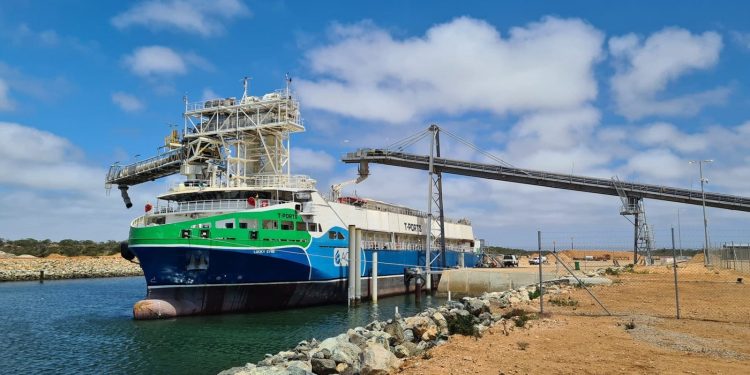Exploring New Opportunities to Enhance Throughput at Lucky Bay and Wallaroo Facilities
T-Ports, an independent bulk handling company in South Australia, is seeking to expand its port capacity to meet the increasing demand from regional stakeholders. Since its inception during the 2019 harvest, T-Ports has successfully exported up to 1 million tonnes of grain annually via its Lucky Eyre transshipment vessel from the Lucky Bay port in Spencer Gulf. The company also operates a facility at Wallaroo on Yorke Peninsula, which opened in 2022.
With both ports now operating efficiently, T-Ports CEO Nathan Kent has announced plans to explore further expansion opportunities. This move aligns with the South Australian Government’s State Prosperity Project (SPP), which focuses on renewable energy and infrastructure development in the Upper Spencer Gulf region.
Addressing Regional Needs
The SPP aims to leverage existing developments and new projects, such as the proposed deepwater port at Cape Hardy by Iron Road, to enhance the region’s infrastructure. Kent highlighted the tight capacity constraints currently faced in the region, emphasizing the need to unlock additional port capacity to support various projects.
“Until Cape Hardy is operating, there’s extremely tight capacity when it comes to unlocking the needs of the region by sea,” said Kent. He added that T-Ports’ Lucky Bay port is well-positioned to assist with SPP construction and export production projects, including minerals and turbine blades for wind farms.
Expanding Grain Capacity
Despite these new opportunities, T-Ports remains committed to its core business of serving grain growers. The company is investing in new equipment and infrastructure, including stackers and deepening the port channel at Lucky Bay. T-Ports is also expanding its grain operations to include lentils, following its first lentil cargo from Wallaroo in December 2023.
Kent mentioned potential developments at both ports, with Wallaroo offering capacity for grain-related infrastructure and Lucky Bay presenting opportunities for broader port and landside developments. The strategic location of Lucky Bay, approximately 500km from Adelaide, positions it as a key site for materials and equipment arrival, reducing reliance on road transport.
Collaborative Efforts
T-Ports is in discussions with ship owners and other ports to explore the use of barges for transferring renewable energy cargoes from break-bulk vessels to shore. This approach, common in the US and Europe, could be replicated in South Australia to support the renewable energy sector.
Kent sees potential for T-Ports to play a significant role in the renewable energy supply chain, similar to hubs in Scotland that have pivoted away from fossil fuels. The company’s Information Memorandum, calling for expressions of interest by August 2, outlines options such as roll-on roll-off capabilities and the development of a pit-to-ship haul road at Lucky Bay.
Future Developments
The development of deepwater terminals at Port Spencer by FREE Eyre’s Peninsula Ports entity and at Cape Hardy by Iron Road are still in planning stages, with construction yet to commence. Meanwhile, Lucky Bay continues to serve as a critical hub for grain exports and regional connectivity, providing daily passenger and vehicular ferry services to Wallaroo.
As T-Ports continues to gauge demand and explore expansion opportunities, the company remains focused on enhancing its service offerings to meet the evolving needs of South Australia’s agribusiness and renewable energy sectors.
Error




